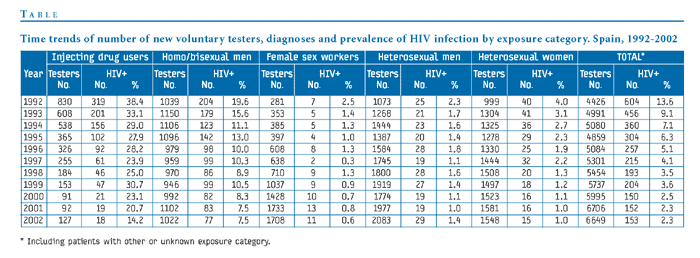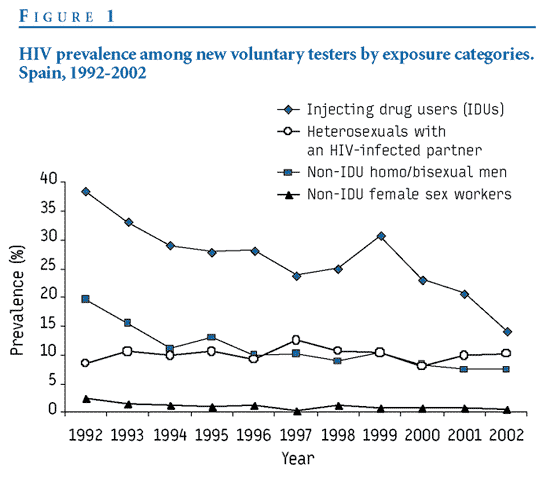| HIV infection in Spain was monitored in
persons
undergoing voluntary HIV testing in ten sentinel clinics between 1992
and
2002. Only patients on their first visit were considered for inclusion,
and their numbers rose from 4426 in 1992 to 6649 in 2002. Most of them
recognised their risk exposure as heterosexual. The proportion of
injecting
drug users decreased from 19% to 2% of the study population, and the
proportion
of female sex workers increased from 6% to 26%. The number of patients
diagnosed with HIV infection declined from 604 in 1992 to 153 in 2002,
and HIV prevalence fell from 13.6% to 2.3% in the same period. In all
risk
exposure categories, a decrease in HIV prevalence was observed, more
pronounced
during the first few years and stabilised in the later years. In 2002,
the highest HIV prevalence was found in injecting drug users (IDUs)
(14.2%),
homo/bisexual men (7.5%) and individuals who had an HIV infected
heterosexual
partner (10.2%).
Introduction In European countries, the epidemiological surveillance of HIV infection combines population based reporting systems and seroprevalence monitoring in specific population groups. The countries most affected by HIV infection have had difficulties in extending reporting systems within their respective territories. Epidemiological surveillance of HIV prevalence in specific groups provides useful information for the planning and evaluation of the preventive activities [1]. In Spain, HIV infection diagnosis is performed in a wide variety of healthcare centres, which has made it difficult to introduce an HIV reporting system to cover the general population. In the major cities there are HIV counselling and testing clinics that perform a large number of HIV tests and diagnoses. Because they are easy to access, these clinics have become the standard providers of this service for specific groups with HIV risk practices, which has consequently permitted very efficient monitoring of the evolution of the infection in these groups [2]. This paper presents HIV surveillance data based on voluntary tests performed in a network of sentinel clinics in Spain between 1992 and 2002. Methods The present study is based on a sentinel
network
of ten sexually transmitted diseases and HIV testing clinics in the
following
cities: Seville, Granada, Malaga, Gij?n, Tenerife, Madrid (two
centres),
Murcia, Cartagena and Vitoria. All of them offer voluntary, anonymous
and
free HIV testing, and have been operating without major changes during
the period of this study. Epidemiological information was collected by
healthcare workers before the HIV test was performed, using a brief
questionnaire.
Patients were grouped in exposure categories according to self-reported
risk situations, and in the following priority order: injecting drug
users
(IDUs), homo/bisexual men, female sex workers, heterosexual men, other
heterosexual women, and other risk exposure groups. Blood specimens
were
tested for HIV by the ELISA method, and reactive sera were confirmed by
western blotting or immunofluorescence. Results Time trends in the number and characteristics of persons having an HIV test The total number of patients undergoing their first HIV test in these clinics increased from 4426 in 1992 to 6649 in 2002. The proportion of women rose from 37% to 51% (p<0.001) and the average age remained about 29 years. The mean age only increased in IDUs, rising from 26.8 to 32.3 years (p<0.001). Throughout the entire period of this study, the majority of patients underwent an HIV test following heterosexual risk exposure. Between 1992 and 2002, the annual number of IDUs who underwent HIV testing dropped by 85%, the number of female sex workers tested increased by a factor of six, the number of heterosexual men tested almost doubled, and the number of homo/bisexual men remained more or less constant [TABLE].  In 2000, despite the increase in the
number of
patients who took the test, the percentage of individuals diagnosed
with
HIV had fallen by 75%, and since then has remained relatively stable.
Seventy
eight percent of patients diagnosed with HIV were men, and their
average
age was 29 years; these figures did not vary noticeably with year of
test. Time trends in HIV prevalence The HIV seroprevalence in the tested population decreased from 13.6% in 1992 to 2.3% in 2002 (p<0.001); however, in the final few years of the study period, the figure became stable. In IDUs, HIV seroprevalence descended from 38.4% to 14.2% (p<0.001) [FIGURE 1], but still remains the highest percentage of all considered risk categories. In the homo/bisexual men category, prevalence descended from 19.6% to 7.5% (p<0.001), this reduction was steeper during the first years. In female sex workers, HIV prevalence dropped from 8.4% in 1992 to 0.8% in 2002 (p<0.001). This decrease is primarily due to the reduction in the number of IDU female sex workers; as a matter of fact, they previously accounted for 15.4% of total female sex workers analysed in 1992, but they only represented 0.5% in 2002. However, a reduction in the HIV prevalence in non-IDU female sex workers was also observed from 2.5% to 0.6% (p=0.008) [FIGURE 2].   Discussion These results draw a favourable time trend in HIV infection between 1992 and 2002 in all of the exposure categories used for analysis. The reductions in prevalences were, in general, more significant at the beginning of the 1990s, and have tended to become stable in the past few years. These trends contrast with the rise in risk behaviours and HIV transmission that have been reported in some studies following the introduction of combination antiretroviral therapies [3,4]. One of the most important findings of this study is the decrease in the proportion of IDUs in new testers; this is due to changes in drug administration routes and to the decreased tendency for young people in Spain to become IDUs [5]. The progressively smaller number of IDUs, which is associated with the highest prevalences, contributes to reduce the overall prevalence of HIV infection in this population of clinic attendees. We did not have information on the patients' nationality, although other studies centred on female sex workers in Spain have shown that there has been a change in their nationality composition, with a pronounced increase of patients who were not born in Spain, and a lower proportion of IDUs [6]. Nevertheless, the increase in the number of tested female sex workers may in part be due to improvements in the clinics' ability to attract members from this category. Homo/bisexual men represent a large and stable component of these clinics' users. Their HIV prevalence decreased during the first years of the study, but subsequently stabilised at rates that can still be considered high, indicating the persistence of high risk behaviour in sexual relations between men [7]. These results, collected in nine cities, are a good reference for the situation and evolution of HIV infection in high risk populations in Spain. This information is of great practical value for the planning and evaluation of preventive actions for these groups. The epidemiological characteristics of HIV-diagnosed patients in these clinics probably do not coincide with the general epidemic pattern in Spain, on account of the over-representation of homosexual men and female sex workers. The HIV prevalences of voluntary testers may be biased; nevertheless, due to the way in which this bias was maintained throughout the study period, the changes in prevalence that have been detected probably indicate true changes in HIV infection in the respective population groups. The characteristics and working methods of these clinics were constant throughout the study period, allowing valid comparisons to be made. Only patients who attended for the first time have been considered in this study. This prevents multiple inclusion of any individual and may improve sensitivity for the detection of recent changes in HIV transmission, as well as helping comparison across different years. The problem of interpreting prevalence in those undergoing repeated HIV tests are made more difficult due to progressive ageing, and the effects of preventive counselling. Of course for those undergoing a first HIV test, we cannot exclude the possibility that some patients had previously been diagnosed elsewhere. HIV seroprevalence monitoring using
voluntary testers
complements other surveillance systems and provides interesting
information
for preventive programmes [1,2]. To interpret the results, however, it
is important to monitor the changes in the number of testers. The EPI-VIH Study Group:J. del Romero, C. Rodr?guez, S. Garc?a, J. Ballesteros, P. Clavo, M.A. Neila, S. del Corral, N. Jerez (Centro Sanitario Sandoval, Madrid); I. Pueyo; M.A. Mendo, M. Rubio (Centro de ETS, Sevilla); C. de Armas, E. Garc?a-Ramos, M.A. Guti?rrez, J. Rodr?guez-Franco, L. Capote, L. Haro, D. N??ez (Centro Dermatol?gico, Tenerife); J.A. Varela, C. L?pez (Unidad de ETS, Gij?n); J.M. Ure?a, J.B. Egea, E. Castro, A.M. Calzas, C. Garc?a, M. Lorente (Centro de ETS, Granada); F.J. Bru, C. Colomo, R. Mart?n, A. Comuni?n (Programa de Prevenci?n del Sida, Madrid); M.V. Aguanell, F. Montiel, A.M. Burgos (Centro de ETS, M?laga); J.R. Ordo?ana, J.J. Guti?rrez, J. Ballester, F. P?rez (Unidad de Prevenci?n y Educaci?n sobre Sida, Murcia); J. Balaguer, J. Dur?n (Centro de Salud ?rea II, Cartagena); J. Ortueta, L.M. S?ez de Vicu?a (Direcci?n Territorial de ?lava); P. Sobrino, A. Barrasa, J. Castilla (Centro Nacional de Epidemiolog?a, Instituto de Salud Carlos III, Madrid).Acknowledgements This work was partly funded by FIPSE (Foundation formed by the Spanish Ministry of Health and Consumer Affairs, Abbott Laboratories, Boehringer Ingelheim, Bristol Myers Squibb, GlaxoSmithKline, Merck Sharp and Dohme, and Roche, exp. 3076/99 and 36303/02) and by the Spanish Red de Investigaci?n en Sida - RIS (Network for Research on AIDS) and the Spanish Red de Centros de Investigaci?n Cooperativa en Epidemiolog?a y Salud P?blica - RCESP (Network for cooperative research in Epidemiology and Public Health). References 1. European Centre for the Epidemiological Monitoring of AIDS. HIV/AIDS Surveillance in Europe. Mid-year report 2002. Saint-Maurice: Institut de Veille Sanitaire, 2002. No. 67.(http://www.eurohiv.org/) 2. Secretar?a del Plan Nacional sobre el Sida. VIH y sida en Espa?a. Situaci?n epidemiol?gica, 2001. Madrid: Ministerio de Sanidad y Consumo, 2002. 3. Stolte IG, Dukers NHTM, de Wit JBF, Fennema H, Coutinho RA. A summary report from Amsterdam: increase in sexually transmitted diseases and risky sexual behaviour among homosexual men in relation to the introduction of new anti-HIV drugs. Euro Surveill. 2002;7: 19-22. 4. Suligoi B, Giuliani M, Galai N, Balducci M and the STD Surveillance Working Group. HIV incidence among repeat HIV testers with sexually transmitted diseases in Italy. AIDS. 1999; 13:845-850. 5. Plan Nacional sobre Drogas. Memoria 1996. Madrid: Delegaci?n del Gobierno para el Plan Nacional sobre Drogas, 1997. 6. The EPI-VIH Study Group. HIV infection among people of foreign origin voluntarily tested in Spain. A comparison with national subjects. Sex Transm Infect. 2002;78:250-254. 7. P?rez K, Rodes A, Casabona J. Monitoring HIV prevalence and behaviour of men who have sex with men in Barcelona, Spain. Euro Surveill. 2002; 7:19-22 |